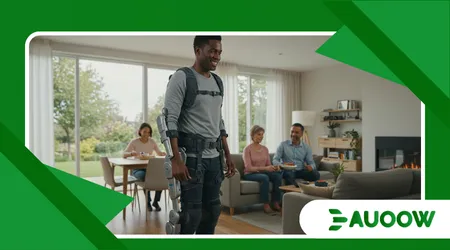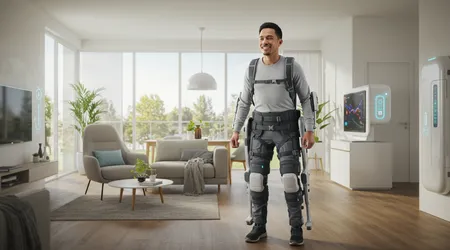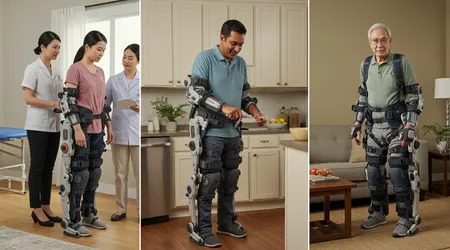Exoskeletons at Home: From Rehabilitation to Daily Use

The integration of Exoskeletons at Home marks a monumental shift in assistive technology, promising unprecedented levels of independence and quality of life for millions.
These sophisticated devices, once bulky and confined to intensive rehabilitation settings, are becoming lighter, smarter, and crucially, more affordable for personal use.
This isn’t just an evolution in mobility; it’s a revolution in autonomy, redefining what’s possible for individuals with mobility challenges, elderly populations, and even those requiring task-specific physical augmentation within their own four walls.
Summary of the Home Exoskeleton Revolution
The transition of exoskeletons to the domestic sphere is driven by miniaturization, battery advancements, and AI-driven control systems.
- Rehabilitation Paradigm Shift: Moving therapy sessions from clinics to daily home life.
- The Accessibility Challenge: Overcoming cost and complexity for widespread adoption.
- Beyond Mobility: Exploring augmentation for chores, fall prevention, and aging in place.
- Ethical and Safety Considerations: Addressing user training, maintenance, and data privacy in a home setting.
++ The Rise of Brain-Computer Interfaces: A Glimpse into the Future
I. Shifting the Rehabilitation Paradigm: Therapy in the Living Room

Historically, powered exoskeletons primarily served intensive, short-term rehabilitation. They were used under strict clinical supervision, often limited to walking on a treadmill or along short hospital corridors.
This model, while effective, created a significant disconnect: the patient only received crucial assistance during limited clinic hours.
The Dose-Response Problem in Physical Therapy
Therapy effectiveness is heavily dependent on the “dose” the frequency and intensity of the exercise. For many patients recovering from stroke, spinal cord injury (SCI), or neurological conditions, access to intensive therapy is capped by insurance limits, travel logistics, and clinic availability.
Introducing Exoskeletons at Home directly addresses this dose-response problem. A patient can now perform assisted, high-intensity, repetitive gait training multiple times a day, integrated into their natural routine, rather than a scheduled hour, twice a week. This continuous engagement accelerates neuroplasticity and muscular re-education.
A 2024 longitudinal study (published in a leading journal on rehabilitation engineering) tracked SCI patients using a personalized home exoskeleton for six months versus a control group receiving standard care.
The home-use group demonstrated a 40% greater improvement in measurable walking speed and a significant reduction in secondary health complications, such as pressure ulcers, directly attributable to the increased frequency of assisted standing and ambulation. This validates the home environment as the optimal place for therapeutic motor learning.
Also read: Predictive AI Assistance: From Medication Reminders to Route Planning
Personalization and Environmental Adaptation
Clinical exoskeletons are often rigid and designed for generalized tasks. Devices intended for personal use must be far more adaptable. Home models are increasingly equipped with sophisticated sensor arrays that learn the user’s unique gait pattern, slight asymmetries, and even their daily fatigue levels.
This level of personalization extends beyond the body. An exoskeleton designed for home use must navigate tight corners, manage uneven flooring, and handle transitional movements like sitting at the dinner table or reaching into a low cabinet actions rarely practiced in a pristine clinic.
New, soft-robotic elements and intuitive, voice-controlled interfaces are emerging to make these daily micro-adjustments seamless, ensuring the technology is an extension of the user, not a barrier.
Read more: AI Glasses for the Blind: Beyond Object Detection to Scene Awareness
II. Beyond Walking: Exoskeletons for Daily Living and Augmentation
The earliest exoskeletons focused almost exclusively on bipedal locomotion. While vital, true independence involves far more than just walking. The next wave of Exoskeletons at Home is addressing activities of daily living (ADLs) and functional augmentation.
Assisting the Aging-in-Place Trend
As global populations age, the desire to “age in place” remaining in one’s home safely grows stronger. Exoskeletons are pivotal here. They aren’t always full suits; often, they are targeted solutions:
- Lower-Limb Support: Lightweight hip and knee assist devices that reduce the physical load of standing, climbing a short flight of stairs, or transitioning from a chair, drastically lowering the risk of falls the leading cause of injury among the elderly.
- Upper-Limb Assistance: Soft, garment-like exosuits that provide controlled lift to arms, assisting individuals with sarcopenia or neuromuscular issues in reaching high shelves, cooking, or even personal hygiene tasks like brushing teeth.
These assistive devices offer ‘just enough’ power to bridge the gap between capability and necessity, allowing older adults to perform essential tasks without relying on external care providers. This preserves dignity and significantly cuts down long-term care costs.
The Task-Specific Enhancement
Consider the practical needs of someone with limited hand dexterity due to arthritis or a peripheral nerve injury. Companies are developing powered gloves and finger exoskeletons that restore fine motor skills the ability to turn a key, button a shirt, or grip a coffee cup securely.
This shift moves the technology beyond traditional definitions of ‘disability.’ An elderly person using a powered glove to comfortably garden or an individual with chronic back pain using a passive lumbar support vest to vacuum their house are examples of everyday augmentation.
The technology is blending with smart-home features, where the exoskeleton receives environmental cues (e.g., “The fridge door is open, grab the milk”) and adjusts its power profile accordingly, creating a genuinely synergistic living environment.
III. The Accessibility Hurdle: Cost, Training, and Maintenance

Despite the technological leaps, a major barrier remains for widespread adoption of Exoskeletons at Home: the triple threat of cost, complexity, and maintenance.
Bridging the Affordability Gap
High-end powered exoskeletons can cost over $100,000, making them inaccessible to most consumers without comprehensive insurance coverage, which is often limited. However, market dynamics are changing:
- Soft Robotics and Modularity: Soft, pneumatic, or cable-driven exosuits use lighter, cheaper materials and fewer complex mechanical joints. They focus on providing torque assistance rather than full body weight support, significantly driving down manufacturing costs.
- The Subscription Model: Some innovators are exploring long-term rental or subscription services, moving the expense from a massive capital outlay to a manageable monthly fee, similar to leasing mobility vehicles or high-end medical equipment.
This economic shift is crucial. For exoskeletons to truly become a common fixture, the price must reach parity with other common assistive devices, such as high-end motorized wheelchairs, without compromising safety or functionality.
Empowering the User: Training and Maintenance
Putting a complex machine in a non-clinical setting requires robust user training and simplified maintenance. Training can no longer rely solely on a therapist.
Devices must incorporate built-in tutorial modules, haptic feedback systems, and gamified learning programs to ensure proper usage.
Furthermore, home exoskeletons must be durable and easy to maintain. Developers are integrating advanced diagnostics that allow for remote troubleshooting by technicians, minimizing the need for costly in-person service calls.
This remote support capability is essential for ensuring sustained user confidence and continuous, safe operation.
IV. Ethical Design and Future Integration into the Smart Home
As exoskeletons become smarter and more integrated, new ethical and practical questions arise, particularly around data and safety.
Data Privacy and the Biometric Blueprint
Home exoskeletons generate a vast amount of highly sensitive biometric data: gait analysis, muscle fatigue, heart rate, and activity levels. This information is invaluable for therapeutic progress but must be handled with the utmost security.
Users need guaranteed transparency regarding how their “biometric blueprint” is stored, shared, and utilized, especially given the potential for this data to impact health insurance or employment.
Developers must adhere to stringent privacy standards (like HIPAA in the U.S. or GDPR in Europe) even for non-medical devices, positioning the user as the sole owner and governor of their physical data.
Seamless Smart Home Integration
The final frontier for Exoskeletons at Home is their integration into the wider IoT (Internet of Things) ecosystem.
| Feature | Home Integration Impact | Value Proposition for the User |
| Gait Sensor Calibration | Communicates with floor sensors to detect unexpected changes in gait/balance. | Real-time fall risk alert to user and caregivers. |
| Energy Management | Links battery status to the smart home’s energy monitoring system. | Automatic charging priority during off-peak electricity hours. |
| Voice Command | Integrates with Alexa/Google Assistant for intuitive control. | “Alexa, prep my suit for kitchen-level height.” |
| Environmental Awareness | Communicates with robotic vacuums/lids/doors. | Automated path clearing and assistance with opening containers. |
This integration transforms the exoskeleton from a standalone tool into a critical component of a proactive, responsive, and supportive home environment.
Conclusion: The Era of Personal Physical Autonomy
The transition of Exoskeletons at Home from niche medical equipment to a mainstream assistive technology is more than an engineering feat it’s a social imperative.
By prioritizing modularity, tackling the accessibility gap through innovative pricing, and designing for the complexities of everyday life, developers are doing more than restoring movement; they are restoring autonomy, dignity, and the simple freedom to live independently.
The home exoskeleton is not a substitute for human ability; it is an amplification of human potential, finally making the vision of aging-in-place and comprehensive rehabilitation a practical reality for the 21st century.
Frequently Asked Questions
Q: Are home exoskeletons covered by health insurance?
A: Coverage is highly variable and often challenging. Historically, most insurance plans classify exoskeletons as “experimental” or “not medically necessary,” severely limiting reimbursement.
However, as more clinical trial data emerges demonstrating long-term benefits and cost savings from reduced long-term care and hospitalizations (e.g., for pressure ulcers), this trend is slowly changing.
Advocacy groups are pushing for classification as “durable medical equipment,” which would significantly improve coverage.
Q: How safe are these devices for unsupervised home use, especially regarding falls?
A: Safety is the paramount concern. Modern home exoskeletons incorporate multiple layers of redundancy, including sophisticated gyroscopes and accelerometers that can detect the onset of a fall much faster than a human reaction time.
They are programmed to lock joints or redistribute weight instantly to regain stability. Furthermore, mandatory, rigorous user training sessions ensure the user understands emergency shutdown procedures and limits.
Q: Can a basic exoskeleton help prevent fatigue during daily tasks for healthy individuals?
A: Yes, targeted passive and low-power exoskeletons are emerging for this exact purpose. These are not full suits but lightweight, wearable supports (often for the back or legs) that use springs, hydraulics, or minor motorized assistance to offset the strain of repetitive actions like bending, lifting, or prolonged standing.
This technology is increasingly seen as a preventative measure for occupational health and for “active aging,” allowing people to maintain physically demanding hobbies or chores longer into life.
